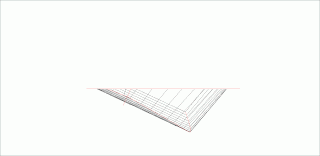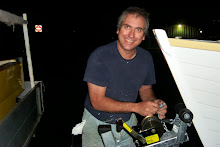 |
| Here is a photo of Black Skimmer, copied from Woodenboat Magazine - I hope I haven't infringed any copyright. She is close to being my absolute favourite design. |
Ross, I love it that you are discussing flat bottomed skiffs. I love 'em. My first sailboat was a Bolger Featherwind which exhibited the design principles you mention in your post. I am not so sure I agree about the curvature in bottom and sides. W/L length gets shortened, more of the bottom is exposed to waves and the pounding is obnoxious (this is not to say that the boat was not a blast to sail). How would John Atkin's Lark (14'3" sailing skiff) stack up to your discussion? It has a fine entry, but the stem is immersed. It has good flare and I would bet that it does not pound the fillings out of your teeth while sailing in a chop. While I have not built and sailed another flat bottomed skiff since owning the Featherwind, I will probably do so one day because the nostalgia of that first boat has a powerful draw. Best, Dennis
I know what Dennis is talking about, and it is a good demonstration of how everything in boat design requires compromise. The shape which provides the excellent sailing behaviour (adequate rocker, matched curvature of the topsides and the bottom panel, forefoot run above the waterline) is very likely to pound badly when floating level.
There are plenty of flat-bottomed skiff designs around which have the forefoot immersed, and scores of William and John Atkin boats provide excellent examples to study. One of my favourite Atkin designs is Ration and she shows exactly what we are talking about.
 |
| Lines of Ration - courtesy of Motor Boating's Ideal Series - Chapman and Horenburger |
To get an appreciation of what I'm trying to describe, compare the shapes I show below: -
 |
| The same boat heeled 25 degrees. In reality, the stern would probably be forced a bit higher and the bow lower than I've shown here, which would make matters even worse. |
 |
| A clearer view of the same boat. See how the chine line will generate turbulence and drag, and will tend to force the boat to round up. |



Hello,
ReplyDeleteThere was a flat bottom sharpie built in England in 1898. Very unusual at the time. She was 14ft and had a sprit main and jib. Mr. Lillistone could you look at this picture of her from Dixon Kemp, and comment on what you think? I'd quite like to build an historical replica to see how she went (fast by all accounts at the time as she was banned from racing).
https://picasaweb.google.com/lh/photo/OYrhbqLKYyB9iQF9G3RN3HY6h4w9_WFXdAPmTale1U0?feat=directlink
Regards
Edward
Hi! A fellow going by Ivor Bittle writes about modifying the bow wave, how the separates, that you mentioned. He used both bulbous bow and control surfaces to do this. He has shown that he could, with control planes, greatly affect where the lower part of the bow wave emerges.
ReplyDeleteMy question to you is playing off the idea of modifying the bow wave in relation to hard chine boats: what do you think, in a displacement power boat, might be achieved by developing an aft tunnel of sorts, maybe something like a shallow inverted V or inverted dead rise (something as old as the work of either Andrade with his "new type" or Hickman with his sea sleds so no innovation there) to give the water from the lower part of the bow wave someplace to go besides back over the chine with the resulting turbulence, not that I imagine that could be outright prevented ... just reduced a bit?
Doh! ... it should say "how the upper and lower part of the bow waves separate" ...
ReplyDeleteJust put a deposit on a black skimmer and REALLY looking forward to a season of a sailing a big little boat, instead of the small big boat that I had (7 ton gaff cutter).
ReplyDelete/sub
ReplyDelete